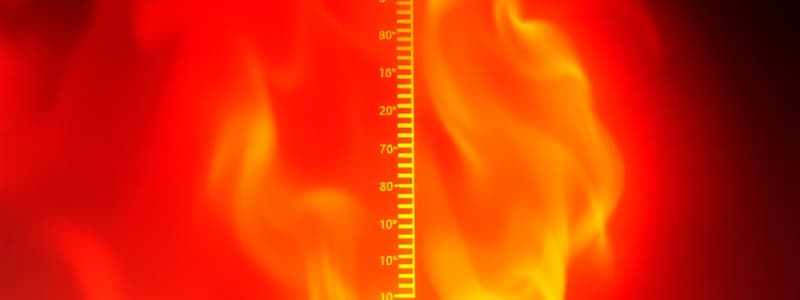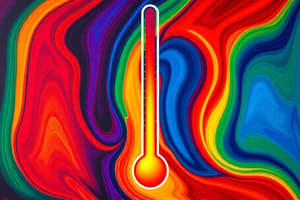Podcast
Questions and Answers
Match the following temperatures with their expressed conversions:
Match the following temperatures with their expressed conversions:
90 °F = Approx. 32.2 °C 300 K = 26.85 °C -78.5 °C = -109 °F 37.0 °C = 98.6 °F
Match the thermal expansion types with their definitions:
Match the thermal expansion types with their definitions:
Linear Thermal Expansion = Change in length due to temperature Area Thermal Expansion = Change in area due to temperature Volume Thermal Expansion = Change in volume due to temperature Thermal Expansion = General tendency of matter to change with temperature
Match the formulas with the correct temperature conversion:
Match the formulas with the correct temperature conversion:
$C = (F - 32) x \frac{5}{9}$ = Celsius from Fahrenheit $F = \frac{9}{5}C + 32$ = Fahrenheit from Celsius $K = C + 273.15$ = Kelvin from Celsius $C = K - 273.15$ = Celsius from Kelvin
Match the temperature conversions with their results:
Match the temperature conversions with their results:
Match the coefficients with their corresponding expressions:
Match the coefficients with their corresponding expressions:
Match the temperature scales with their freezing points:
Match the temperature scales with their freezing points:
Match the definitions with their applications:
Match the definitions with their applications:
Match the concepts with their importance in thermal physics:
Match the concepts with their importance in thermal physics:
Match the temperature scales with their characteristics:
Match the temperature scales with their characteristics:
Match the temperature conversion formulas:
Match the temperature conversion formulas:
Match the terms with their definitions:
Match the terms with their definitions:
Match the descriptions with the correct temperature scale:
Match the descriptions with the correct temperature scale:
Match the characteristics with the correct measurement methods:
Match the characteristics with the correct measurement methods:
Match the temperature increments between scales:
Match the temperature increments between scales:
Match the key points about heat transfer:
Match the key points about heat transfer:
Match the measurement scales with their boiling points of water:
Match the measurement scales with their boiling points of water:
Match the following symbols with their meanings in the heat transfer equation:
Match the following symbols with their meanings in the heat transfer equation:
Match the following temperatures with their respective definitions:
Match the following temperatures with their respective definitions:
Match the following substances with their specific heat capacities:
Match the following substances with their specific heat capacities:
Match the following heat transfer methods with their descriptions:
Match the following heat transfer methods with their descriptions:
Match the following numerical values with their corresponding physical quantities:
Match the following numerical values with their corresponding physical quantities:
Match the following components with their roles in the heat transfer equation:
Match the following components with their roles in the heat transfer equation:
Match the following heat calculations with their corresponding examples:
Match the following heat calculations with their corresponding examples:
Match the following temperature increments with their usage:
Match the following temperature increments with their usage:
Match the following concepts with their definitions:
Match the following concepts with their definitions:
Match the following formulas with their corresponding applications:
Match the following formulas with their corresponding applications:
Match the following materials with their coefficients of linear expansion:
Match the following materials with their coefficients of linear expansion:
Match the following scenarios with their results of thermal expansion:
Match the following scenarios with their results of thermal expansion:
Match the following terms with their units:
Match the following terms with their units:
Match the following applications with their respective temperatures:
Match the following applications with their respective temperatures:
Match the following values with their calculations:
Match the following values with their calculations:
Match the following heat transfer terms with their caloric values:
Match the following heat transfer terms with their caloric values:
Match the heat transfer mechanisms with their descriptions:
Match the heat transfer mechanisms with their descriptions:
Match the variables in the thermal conduction equation with their meanings:
Match the variables in the thermal conduction equation with their meanings:
Match the components involved in the radiation formula with their definitions:
Match the components involved in the radiation formula with their definitions:
Match the example with its related term:
Match the example with its related term:
Match the temperature scales with their conversions:
Match the temperature scales with their conversions:
Match the heat transfer example with its mechanism:
Match the heat transfer example with its mechanism:
Match the thermodynamic variables with their relationships:
Match the thermodynamic variables with their relationships:
Match the specific heat capacity expressions with their scenarios:
Match the specific heat capacity expressions with their scenarios:
Flashcards are hidden until you start studying
Study Notes
Heat & Temperature
- Heat is the transfer of thermal energy from a warmer object to a cooler one.
- Thermal equilibrium occurs when two objects in contact do not exchange energy, indicating they are at the same temperature.
Temperature
- Temperature is a fundamental SI base quantity, measured in Kelvins (K).
- It reflects an object's degree of hotness or coldness.
- Thermometers are used to measure temperature.
Zeroth Law of Thermodynamics
- If object A is in thermal equilibrium with object C, and object B is in thermal equilibrium with C, then A and B are in thermal equilibrium with each other.
Temperature Measurement Methods
- Common temperature scales include Celsius (℃), Kelvin (K), and Fahrenheit (℉).
- Fixed points, where certain physical properties are stable, are critical for establishing temperature scales.
Temperature Conversion
- Freezing and boiling points of water:
- Celsius: 0°C (freezing), 100°C (boiling).
- Fahrenheit: 32°F (freezing), 212°F (boiling).
- Conversion formulas:
- Celsius to Fahrenheit: (T_F = \frac{9}{5}T_C + 32)
- Fahrenheit to Celsius: (T_C = \frac{5}{9}(T_F - 32))
- Celsius to Kelvin: (T_K = T_C + 273.15)
Thermal Expansion
- Thermal expansion describes how matter changes in length, area, and volume with temperature changes.
- Types of thermal expansion:
- Linear expansion: Change in length
- Area expansion: Change in area
- Volume expansion: Change in volume
Linear Thermal Expansion
- Formula: (\Delta L = \alpha L_i \Delta T)
- (\Delta L): Change in length
- (\alpha): Coefficient of linear expansion
- (L_i): Initial length
- (\Delta T): Change in temperature
Area and Volume Expansion
- Area Expansion: (\Delta A = 2\alpha A_i \Delta T)
- Volume Expansion: (\Delta V = \beta V_i \Delta T)
- (\beta = 3\alpha)
- Coefficients of expansion vary by material.
Quantity of Heat and Specific Heat
- Quantity of heat (Q) is energy transferred due to temperature difference, measured in joules (J), calories (cal), or kilocalories (Cal or kcal).
- Relationships:
- (1 \text{ cal} = 4.186 \text{ J})
- (1 \text{ kcal} = 1000 \text{ cal})
- Specific heat (C): The heat needed to raise 1 gram of a substance by 1°C.
- Formula: (Q = mC\Delta T)
Heat Transfer Mechanisms
- Conduction: Heat transfer through molecular collisions in solids.
- Convection: Heat transfer in fluids due to the movement of higher energy molecules.
- Radiation: Heat transfer through electromagnetic radiation, can occur in a vacuum.
Calculation Examples
- Example calculations demonstrate how to calculate changes in temperature, specific heat capacities, and the amount of heat transferred in various contexts.
- Important relationships and conversions for specific materials provide insight into real-world applications of thermodynamic principles.
Studying That Suits You
Use AI to generate personalized quizzes and flashcards to suit your learning preferences.




